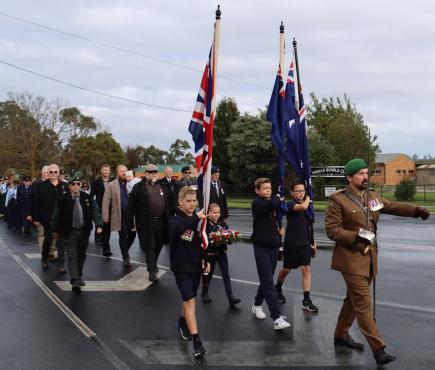ANZAC Day 2024 - Yinnar
Captain Retired Luke Townsend MBE MA lead the Service.

Special Mentions
“Special mention and thanks is to be given to Fl. Lt. Wayne Bass, the Staff and Cadets from 424 Sq. ATC for continuing support here and at Morwell later today, the Morwell Caledonian Band for the pipes and drums and Bugler. A special welcome was also given to all the youths and school children attending today’s service and to lay wreaths, as well as members of the Yinnar Lions Club and veterans who have helped in the organisation of this day.
On this day above all days, we recall those who served in all wars in the defence of our nation and did not return home to receive the grateful thanks of their nation. May they rest proudly in the knowledge of their achievements and sacrifices and may we and our successors prove worthy of their sacrifices and never forget them.
Introduction of Guest Speaker
This year the school children will explain what each of our local white crosses mean while two of our local ex servicemen place them for us: Former Commando and dear friend Bruno Saulle and Former Sailor Gareth Peters.
Womans Land Army (Alex)
The Australian Women’s Land Army (AWLA) was established in the Second World War. It was all about making more food during the Second World War. An incredible number of women joined the organisation, around 80,000.
The R.A.N (Alex)
The R.A.N stands for the Royal Australian Navy. The Royal Australian Navy is part of the Australian Defence Force. The Royal Australian Navy is the most powerful and one of the largest, most sophisticated Naval forces in the Pacific region.
HMAS Canberra (Zoe)
HMAS Canberra was a cruiser commissioned in the Royal Australian Navy in 1928. During World War 2 the Canberra served in both the South Atlantic and Indian Oceans. Canberra was sunk during the battle of Savo Island, with the loss of 84 Sailors.
Burma Railway (Zoe)
The Burma Railway was built in 1942-43 by the Japanese, and prisoners of war taken by the Japanese, to supply troops and weapons in the Burma Campaign of World War 2. More than 90,000 Asian civilians died on the railway, as well as 16,000 Prisoners of War. About 2800 of those who died were Australian.
Buna (Alice)
Buna is a coastal village in Northern Papua and was the main base for the Japanese advance along the Kokoda Trail. The battle of Buna cost the Allied forces 2 870 causalities.
Ambon (Alice)
Ambon is an island in Indonesia. The battle at Ambon started on January 30, 1942 and went until February 3, 1942. About 300 men who were protecting the Laha airfield on Ambon were killed in four separate massacres around the airfield.
RAAF Aircrew (Eleanor)
The RAAF stands for Royal Australian Air Force. The Australian Air Force was formed on March 31, 1921. The RAAF then became the second Royal air arm to be formed in the British Commonwealth, following the British Royal Air Force. At the end of World War 11 the RAAF was the fourth largest Airforce in the world, with 6,000 aircraft.
8.B Lamsdorf (RAAF) (Eleanor)
8.B Lamsdorf was a large, German prisoner of war camp, later renumbered Stalag 344. It was located near the village of Lamsdorf. 84 captured RAAF aircrew were held at the huge 8B Lamsdorf camp during World War 11.
Scarlet Beach (Caity)
Scarlet Beach was the first Australian Amphibious landing since Gallipoli. It occurred on the Huon Peninsula, Papua New Guinea, and led to the capture of Finschhafen by the Australian 2/15th battalion on September 23, 1943. It was counter-attacked by the Japanese on November 21, 1943. The Australian and American defenders narrowly stopped the Japanese from re-taking the land.
Battle of Sattelberg (Caity)
The Battle of Sattelberg (October 29-November 25, 1943) saw Australian troops capture a strongly defended Japanese position in the hills to the north-west of Finschhafen and Scarlett beach, and helped secure their position on the eastern tip of the Huon Peninsula.
HMAS Arunta (Aimee)
The original HMAS Arunta (I), commissioned in 1942, became one of the best known RAN ships in World War II. She served with distinction in New Guinea and the Pacific between 1942-1944, the Battle of Leyte Gulf in 1944 and Lingayen Gulf in 1945.
The HMAS Swan (Aimee)
HMAS Swan (U74), named for the Swan River, was a Royal Australian Navy ship in World War 2. Swan was involved in many battles, including the defence of Timor and Darwin and often worked with HMAS Arunta. The Japanese signed the formal surrender of all their forces in New Ireland on board HMAS Swan on September 18, 1945.

Lone Pine, Gallipoli
We have a final marker to place. In 1915 a stalemate had developed on the Gallipoli Peninsula between the combined British and ANZAC forces and the Turks. To break out of this a British, Indian and New Zealand Force was going to launch a major offensive in the north of the Peninsula. To draw attention away from this attack a diversion against the Turks in front of the Australian position was planned. There was a place called Lone Pine, because the Turks had cut down all the other trees leaving a lone Turkish pine near their trenches, and this was selected for the diversion attack. The Australian Division was under the command of a British Officer, Brigadier General Harold Walker. Walker saw that any attack even a diversionary attack was going to be a desperate affair and informed higher command that it was going to be costly. Higher command insisted on the attack, so Walker went to great lengths to ensure every possible preparation was made in the lead up to the battle. These preparations proved fruitful and when the first wave was launched over the top, they managed to get to the Turkish lines with minimal casualties. However, the Turks launched a series of massive counter attacks on the Lone Pine position. Afterward, Walker described the result as disastrous.
Of the 4,600 Australians committed to the battle, over a front of just 150 meters: 2,277 were casualties with over 1000 of those being killed. That is about seven dead Australians for every metre of front held. A recent Turkish study of their losses at Lone Pine puts their casualties at 7164. Seven Victoria Crosses, our highest military honour were awarded to Australians for this battle.
A very desperate affair indeed. One soldier who survived the battle and came home was Thomas Keith McDowell. While at Lone Pine he had picked up a pine cone from the shattered tree. Years later, his aunt grew four seedlings from this and it was decided that further Lone Pine Seedlings would be grown for the 50th anniversary of the Gallipoli campaign, in 1965. But Turkish Pine are notoriously difficult species to grow and years passed before they managed to get 150 pine trees from the four in existence. These were sent to RSL branches around the country. Roy Gauer was a soldier who had been wounded at Gallipoli. Roy had his heel shot off and while being evacuated a shell burst killed the stretcher bearer who was carrying him and removed much of Roy’s left arm. As a result he was later awarded one of the soldier settlement farms here, in Yinnar. On this day in 1969, 54 years after the battle, Roy planted this tree to the right of the Cenotaph. It is very special. There are many Lone Pine around the country, but most are from Aleppo Pine and other species that were brought to Gallipoli by the Turks for use in making their trenches. Even the pine at the Lone Pine cemetery in Gallipoli is not a Turkish Pine like the original. There are only very few of these actual descendants of the Lone Pine in existence. How special for us to have this tree in our midst every day as a reminder of a place where so many Australians fell.”


